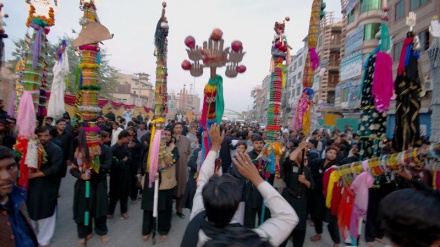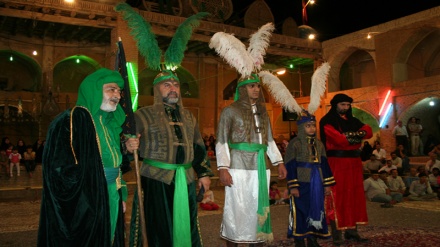Muharram mourning traditions in different lands - 38
Welcome to the 38th part of the series titled “Muharram mourning traditions in different lands” that we started broadcasting as of October 15 on a daily basis, to commemorate the heartrending tragedy of Karbala, and the martyrdom of Imam Husain (AS), the grandson of Prophet Mohammad (SAWA).
In this series, which delves into the mourning traditions associated with the Immortal Epic of Ashura, we have been focusing on the various norms prevalent in different towns and cities of Iran for commemorating the heartrending tragedy of Karbala, after having dwelt on the history of mourning in different countries of the world for Imam Husain (AS). Today we talk about the tradition of “Tasht-Gozari”, which literally means the placing of a tub and filling it with perfumed water or sherbet for the mourners. It is mostly observed in the northwestern Iranian city of Ardabil, and begins three days before the start of Muharram on Zil-Hijja 27.
As we have explained in our early episodes, the heartrending tragedy of Ashura is commemorated during the months of Muharram and Safar, in which discourses are held on the various dimensions of the movement of Imam Husain (AS) and its social impacts over the past 14 centuries in the Muslim World and beyond. We have said how mourning processions that are actually the symbol of military honours for the deceased, are taken out in Iran, Iraq, Arab lands, the Subcontinent, the Caucasus, Turkey, and some African states, as a tribute to the dynamic personality of the Prophet’s grandson who by courting martyrdom in combat, safeguarded Islam and all humanitarian values.
Dressed in shades of black to keep with the military nature of the processions, mourners simulate self-flagellation with light-weight chains to the thump of a bass drum. At the fore of the march, several men bear the immense weight of an ornate apparatus called “Alam” or “standard” on their shoulders and a eulogist chants verses about the tragedy of Karbala. It is interesting to note that blended with local culture mourning ceremonies have evolved in their own peculiar ways in different parts of the world and in different regions of Iran. One such mourning ceremony for Imam Husain (AS), in Iran’s northwestern city of Ardabil is famous as “Tasht-Gozari”.
The tradition highlights the importance of water in Karbala where the Godless Omayyad hordes had blocked all access to the waters of the River Euphrates, and for three days before martyrdom, kept the Imam, his companions, his kith and kin including the noble ladies and children of the Ahl al-Bayt thirsty. This ceremony is well known all over Iran.
Driving to Ardabil, passengers face the welcome sign of the city, which reads: Welcome to the City of Husseini People. The Ardabili people chant elegies in their native Azari-language concerning the tragedy of Karbala. “Tasht-Gozari” is one of traditions, which has been performed for centuries in the city. However, other Iranian cities perform the tradition nowadays. Probably the origin of the “Tasht-Gozari” dates back to the Safavid era. The most ancient existing tub of Ardabil is kept in mosque of Chaqusazan Bazaar, which dates back to the era of Shah Abbas I (1571–1629) and on its edge engraved: “Dedicated to Hazrat Abbas (AS) in 1038 AH”.
“Tasht-Gozari” is performed in over 200 mosques in six main neighborhoods of the city. In all the mosques, some platforms are designed for keeping copper and brazen tubs during the year. Before beginning of Muharram, women from different parts of the city clean mosques and wash the wash tubs preparing them for “Tasht-Gozari”. Each year, the tradition is performed at the Ardabil Jame’ Mosque on Zil-Hijjah 27. Other mosques perform the ritual on other days of Muharram.
There are six tubs representing six neighborhoods of Ardabil at the Jame’ Mosque. The patriarchs from the city’s six neighborhoods gather at the mosque on the specified day. After attending the mourning ceremony, the representatives from each neighborhood hold wash tubs on their head while entering the mosque. They go around the mosque and people touch wash tubs to express their allegiance with Imam Husain (AS). Then they put the tubs on the specified platforms in the mosque and after putting all the six wash tubs on the place, mourners bring jars full of water and pour them into wash tubs. During the ten days, the mourners drink the water from the tubs, believing it is healer and take it for patients as well. Lighting candle and recounting a special prayer named “Fateheh” during the event is other aspects of the ritual.
Well we have come to the end of our programme today. In our next programme, tomorrow, we will have more to say about customs and traditions associated with Muharram and Ashura in Iran. Until tomorrow, goodbye and God bless you all.
MD/AS/EA


